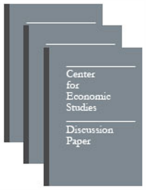The Long-Run Demand for Labor: Estimates From Census Establishment Data
The Long-Run Demand for Labor: Estimates From Census Establishment Data
Abstract
This paper estimates long-run demand functions for production workers, production worker hours, and nonproduction workers using micro data from U.S. establishment surveys. The paper focuses on estimation of the wage and output elasticities of labor demand using data on over 41,000 U.S. manufacturing plants in 1975 and more than 30,000 plants in 1981. Particular attention is focused on the problems of unobserved producer heterogeneity and measurement errors in output that can affect labor demand estimates based on establishment survey data. The empirical results reveal that OLS estimates of both the own-price elasticity and the output elasticity of labor demand are biased downward as a result of unobserved heterogeneity. Differencing the data as a solution to this problem greatly exaggerates measurement error in the output coefficients. The use of capital stocks as instrumental variables to correct for measurement error in output significantly alters output elasticities in the expected direction but has no systematic effect on own-price elasticities. All of these patterns are found in estimates that pool establishment data across industries and in industry-specific regressions for the vast majority of industries. Estimates of the output elasticity of labor demand indicate that there are slight increasing returns for production workers and production hours, with a pooled data estimate of .92. The estimate for nonproduction workers in .98. The variation in the output elasticities across industries is fairly small. Estimates of the own-price elasticity vary more substantially with the year, type of differencing used, and industry. They average -.50 for production hours, -.41 for production workers, and -.44 for nonproduction workers. The price elasticities vary widely across manufacturing industries: the interquartile range for the industry estimates is approximately .40.
Others in Series
Working Paper
Working Paper
Working Paper




